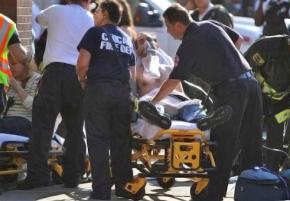Almost a deadly disaster
A terrible tragedy was narrowly averted in Chicago last Sunday when a smoky fire in a subway tunnel threatened passengers on the Chicago Transit Authority's Red Line trains.
The blaze happened near the near-North side station at Clark and Division, apparently because several railroad ties caught on fire. Riders on a train traveling north toward the station described smoke billowing into their cars. Cell phone photos and videos from inside the car showed smoke so thick that passengers couldn't see across the aisle by the time the train got to the station, and riders dashed for the exit.
There were no fatalities, but 19 people were sent to the hospital, five with serious cases of smoke inhalation.
, a SocialistWorker.org contributor and the author of a forthcoming book on a case of arson and wrongful conviction in 1940s Chicago, was on the Red Line train that filled with smoke. Here, he describes the background to the fire.
I WAS one of the lucky passengers who escaped with no injuries from a fire on the Chicago subway system's Red Line on June 20. Nineteen other unfortunate people suffered smoke inhalation and respiratory problems and were sent to Chicago area-hospitals.
Chicago Transit Authority (CTA) President Richard Rodriguez promises a thorough investigation of the incident, which could have had much more serious consequences.
I can safely say that little will come from any investigation from the CTA.
The events on June 20 were very similar to a previous incident on July 11, 2006, when a rear-car derailment caused a smoky fire on the CTA's Blue Line. Again, there were injuries from smoke inhalation, but no fatalities. Like the events of four years ago, much of the distress of last Sunday was caused by the absence of trained personnel who could have helped alleviate the crisis. Nothing has changed in the four years since.
Several years ago, the CTA successfully got the union representing train operators to eliminate conductors from subway cars. This means one person (the train operator) is responsible for both driving the train and the safety of passengers.

This is a recipe for disaster when stuck under the city's streets in a darkened, smoke-filled tunnel. Conductors should be put back on all trains, and along with the train operators, should be given respirators that allow them to do their jobs in an emergency.
As someone who has spent the last two years researching and writing about fires, I can say that the city just barely escaped a major catastrophe in both CTA fires. Most people, who die in fires, don't die from the flames, but the smoke and heat. According to the Federal Emergency Management Agency: "Heat and smoke from fire can be more dangerous than the flames. Inhaling the super-hot air can sear your lungs. Asphyxiation is the leading cause of fire deaths, exceeding burns by a three-to-one ratio."
The smoke that filled my train car was becoming difficult to breath, and as I crouched down on the car floor, covering my mouth with my shirt, I couldn't help but wonder if we had only a few minutes before many of us might not be in the condition to walk out of there. All of my fellow passengers acted admirably, and we left the Clark and Division station in an orderly fashion despite the chaotic situation.
One of the absurdities of this situation is that the CTA doesn't spend money on conductors, but it does spend money on several private security companies that provide no security during a fire emergency. Securitas and others man the turnstiles and the CTA booths above ground and prowl the platforms with muzzled German Shepherds (an eerie reminder of apartheid South Africa or the Jim Crow South).
Let's put the money back into safety and not into the pockets of the Mayor's friends.


